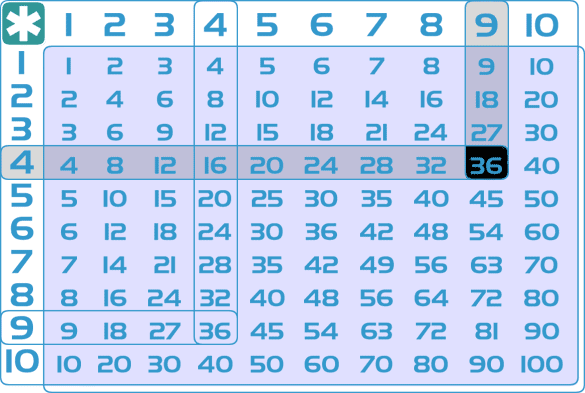What Is Multiplication?
Congratulations. You've got a handle on addition and subtraction. It's time to move to the next level in arithmetic. Multiplication is going to seem easy to you. Multiplication is basically addition that is repeated over and over.Addition: 3 + 3 + 3 + 3 + 3 = 15
Multiplication: 5 x 3 = 15
Instead of writing out a bunch of addends in a long addition problem, we can group them together and multiply.
That's all there is. You are able to add multiple groups in a quick way. You might use multiplication to figure out how many pages are in a book with ten (10) chapters. You could also use multiplication to find out the thickness of a book if you know the thickness of one page.
Setting up a Multiplication Problem
The values you are multiplying are called the factors. The answer in a multiplication problem is called the product. You find the product when you multiply two or any number of factors. There are a lot of symbols used in multiplication. Your basic work will use an "x" (x). It is called a "times" symbol. If you read a multiplication problem out loud in front of your class, you would say, "Two times two equals four." When you write the numbers, you get "2 x 2 = 4".Example:
Twenty-five times sixty-eight equals one thousand seven hundred. 25 x 68 = 1,700
Factors: 25 and 68
Product: 1,700
Multiplying from One to Ten
We like to start small, so let's look at the numbers one (1) to ten (10). Here are some examples using the number two (2).2 x 1 = 2 (one set of two is equal to two: 2 = 2)
2 x 2 = 4 (two sets of two equals four: 2 + 2 = 4)
2 x 3 = 6 (three sets of two equals six: 2 + 2 + 2 = 6)
2 x 4 = 8 (four sets of two equals eight: 2 + 2 + 2 + 2 = 8)
2 x 5 = 10 (five sets of two equals ten: 2 + 2 + 2 + 2 + 2 = 10)
2 x 6 = 12 (2 + 2 + 2 + 2 + 2 + 2 = 12)
2 x 7 = 14 (2 + 2 + 2 + 2 + 2 + 2 + 2 = 14)
2 x 8 = 16 (2 + 2 + 2 + 2 + 2 + 2 + 2 + 2 = 16)
2 x 9 = 18 (2 + 2 + 2 + 2 + 2 + 2 + 2 + 2 + 2 = 18)
2 x 10 = 20 (2 + 2 + 2 + 2 + 2 + 2 + 2 + 2 + 2 + 2 = 20)
Do you see the patterns? Do you see the way multiplication makes it easier to write the numbers in a math problem? When it comes down to it, doing all of that addition (over and over) is a waste of time. You need to memorize the table that is the core of multiplication.
Core of Multiplication
Sorry about this, but you will need to memorize a few values here. In the same way that you learned the basics of addition and adding numbers from 1-10, you need to do the same for multiplication. There's not much we can do but show you the table. The numbers on the top and left side of the grid are the two numbers you need to multiply. Your answer (product) is in the grid where the two lines intersect. We'll cover more about this on other pages, but here is the basic chart.In the chart, we highlight four times nine (4 x 9). When you look along the chart you can see that 4 x 9 = 36.

Useful Reference Materials
Wikipedia:https://en.wikipedia.org/wiki/Arithmetic
Encyclopædia Britannica:
http://www.britannica.com/topic/arithmetic
Encyclopedia.com:
http://www.encyclopedia.com/topic/arithmetic.aspx





